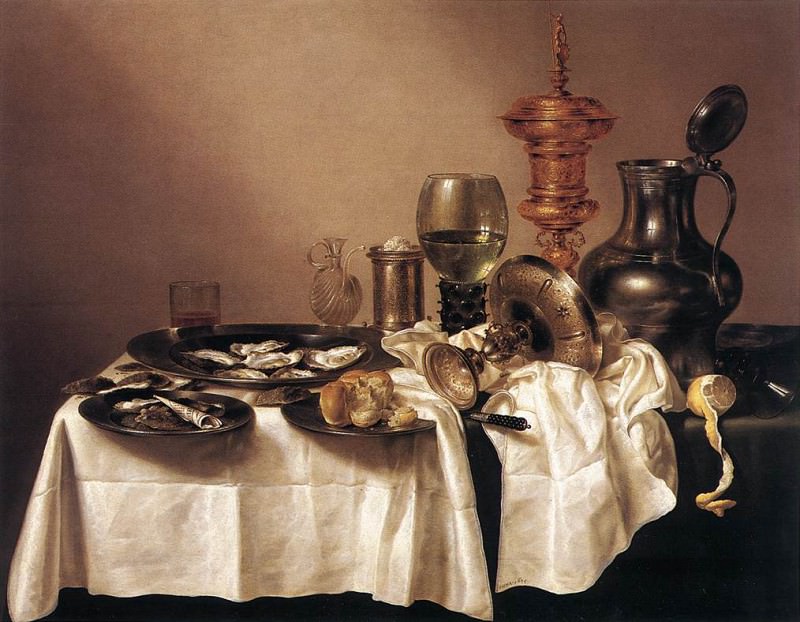goblet Willem Claesz Heda
Willem Claesz Heda – goblet
Edit attribution
Download full size: 1014×788 px (0,1 Mb)
Back to album: Willem Claesz Heda
It is interesting that Heda, the creator of amazing still life paintings, first tried his hand at painting portraits and subjects on religious themes. Only much later he stopped at still life painting, where he became famous as a great master. You can see that in the paintings of this painter present the same objects, just slightly rearranged or diluted with some innovations. Why is that? The explanation is simple.
Description of Willem Head’s painting "Still Life"
It is interesting that Heda, the creator of amazing still life paintings, first tried his hand at painting portraits and subjects on religious themes. Only much later he stopped at still life painting, where he became famous as a great master.
You can see that in the paintings of this painter present the same objects, just slightly rearranged or diluted with some innovations. Why is that? The explanation is simple. Heda came from a time when not everything could be spoken openly, so certain signs had flower buds, colors of clothing, and even certain poses.
Of course, paintings were also able to "talk." So, for example, a ham on the table signified the joys of feeling, silverware expressed wealth and riches, an extinguished candle signified someone’s extinguished life, and the lemon was a sure sign of freshness and beauty, seasoned with a hint of bitterness.
Hed’s still lifes could be read like notes. The clutter on the tabletop reflects a certain confusion of life. A light tablecloth of fine, rich material should be impeccably smooth and clean, as, ideally, is our life, yet no one has yet been able to boast of such flawlessness.
Very often instead of a smooth cloth there are folds, wrinkles, stains, and sometimes huge folds. Or even the entire "tablecloth" of life is rolled up in a ball and there is no time to straighten it out. Silverware is tall and noble, but a goblet with wine is slumped over on its side, probably for a reason, too.
The filled glass, on the other hand, remained standing, gleaming with its rounded sides. Of course, every feast of life has its own "lemon," here it is written brightly, stands out juicy spot, though, already tried, incised skin dangling dejectedly from the table. The lemon is no longer needed.
Hed’s favorite brown tones give the whole still life a kind of warmth. Even the clutter here looks refined and elegant.
Кому понравилось
Пожалуйста, подождите
На эту операцию может потребоваться несколько секунд.
Информация появится в новом окне,
если открытие новых окон не запрещено в настройках вашего браузера.
You need to login
Для работы с коллекциями – пожалуйста, войдите в аккаунт (open in new window).




















You cannot comment Why?
The composition presents a lavish still life arranged on a draped table against a dark, indistinct background. A central focus is drawn to a large, ornate goblet dominating the upper portion of the scene; its gilded surface reflects light and contributes to the overall sense of opulence. The arrangement includes an assortment of silver vessels – platters, pitchers, bowls – alongside a selection of food items: oysters piled on a dark plate, bread rolls, and a lemon resting near the edge of the table. A loosely folded white cloth cascades over the table’s surface, creating folds that add depth and texture to the scene.
The artists meticulous attention to detail is evident in the rendering of textures – the sheen of silver, the pearlescent quality of the oysters, the crispness of the linen, and the translucence of the glass. Light plays a crucial role, illuminating certain objects while leaving others shrouded in shadow, enhancing the three-dimensionality of the arrangement. The use of chiaroscuro creates a dramatic effect, emphasizing the richness of the materials depicted.
Beyond the purely descriptive elements, the painting suggests themes of abundance and luxury. The presence of oysters, considered delicacies, alongside fine silver tableware, implies wealth and privilege. The carefully arranged composition could be interpreted as an allegory for the fleeting nature of earthly pleasures – a vanitas motif subtly embedded within the display of material possessions. The dark background serves to isolate the objects, intensifying their symbolic weight and prompting contemplation on mortality and transience. The lemon, with its association with bitterness or decay, might further reinforce this underlying message. Ultimately, the work invites viewers to consider not only the beauty of the arrangement but also the deeper philosophical implications it conveys about human existence and the pursuit of pleasure.